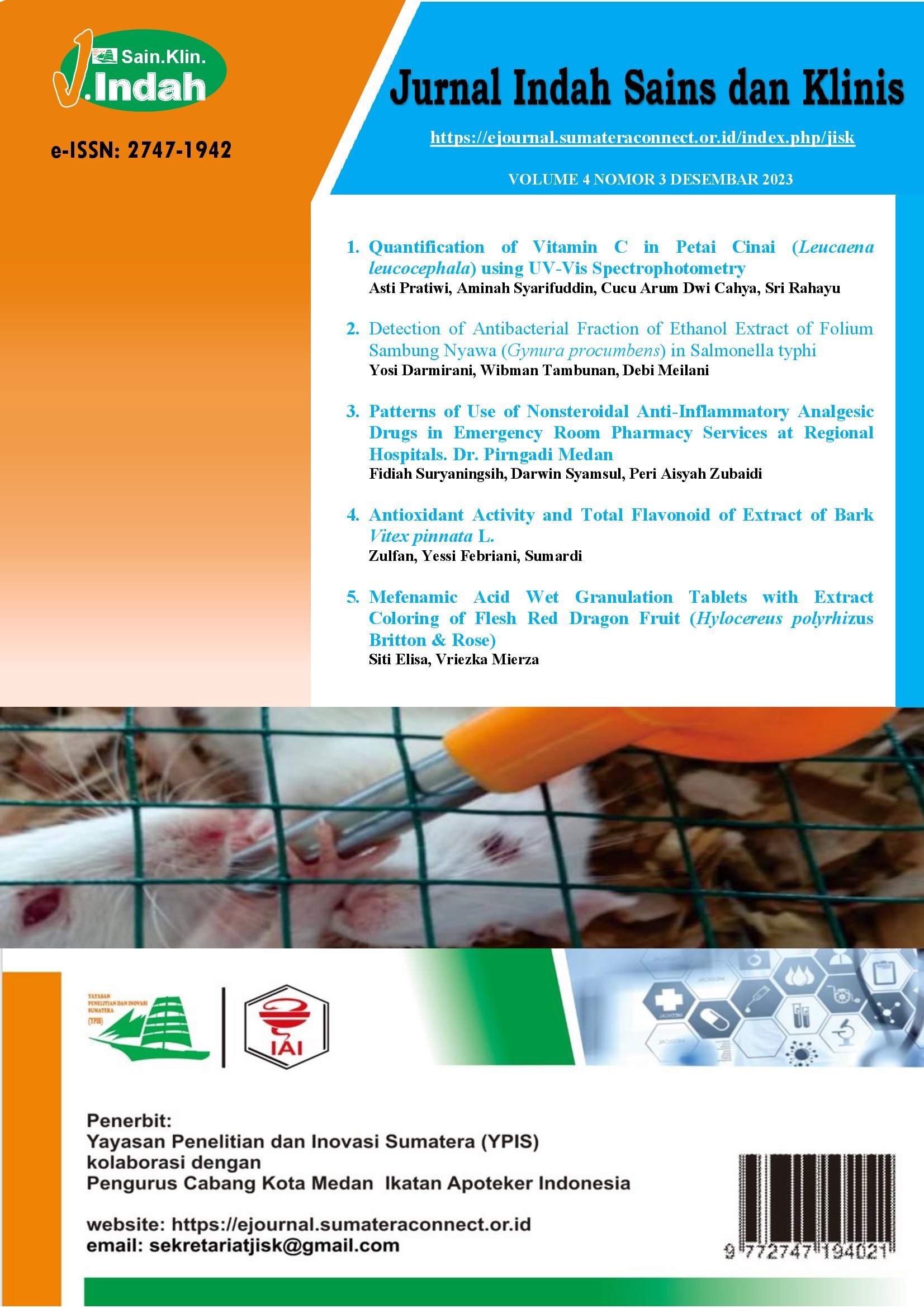Detection of Antibacterial Fraction of Ethanol Extract of Folium Sambung Nyawa (Gynura procumbens) in Salmonella typhi
DOI:
https://doi.org/10.52622/jisk.v4i3.02Keywords:
Folium, flavonoids, ethyl acetate fraction, Salmonella typhiAbstract
Background: Folium Sambung Nyawa, a native plant in Indonesia, is known for its abundant medicinal properties. Among its various secondary metabolites, flavonoids stand out, being polyphenolic compounds found in numerous plants and foods. Flavonoids exhibit a wide range of bioactive properties, including antibacterial, anti-inflammatory, anti-diabetic, anti-cancer, anti-ageing, and antioxidant effects. Objective: This study aimed to assess the antibacterial potential of Sambung Nyawa Leaf extract fractions against Salmonella typhi bacteria. Methods: The antibacterial activity was evaluated using the paper disc diffusion method to determine the inhibition zones. Three fractions---n-hexane, ethyl acetate, and water---were tested at concentrations of 10%, 20%, and 30% each, along with negative controls (DMSO) and positive controls (Chloramphenicol). Results: Flavonoid examination using synode reagent yielded positive results. Among the fractions tested, the 30% ethyl acetate fraction exhibited the most promising antibacterial activity, with an inhibition zone of 7.65 mm, indicating strong efficacy against Salmonella typhi bacteria. Conclusion: The findings suggest that the ethyl acetate fraction of the concentrated Sambung Nyawa leaf extract possesses potent antibacterial properties against Salmonella typhi bacteria
Downloads
References
W. Wahyulianingsih, S. Handayani, and A. Malik, “Penetapan Kadar Flavonoid Total Ekstrak Daun Cengkeh (Syzygium aromaticum (L.) Merr & Perry),” J. Fitofarmaka Indones., vol. 3, no. 2, pp. 188–193, 2016.
S. Saranani, H. Himaniarwati, W. O. Yuliastri, M. Isrul, and A. Agusmin, “Studi Etnomedisin Tanaman Berkhasiat Obat Hipertensi di Kecamatan Poleang Tenggara Kabupaten Bombana Sulawesi Tenggara,” J. Mandala Pharmacon Indones., vol. 7, no. 1, pp. 60–82, 2021.
X. Meng et al., “Traditional Uses, Phytochemistry, Pharmacology and Toxicology of the Genus Gynura (Compositae): a Comprehensive Review,” J. Ethnopharmacol., vol. 276, p. 114145, 2021.
R. M. Rumanti, S. Suprianto, J. Tarigan, and A. M. S. Ramadani, “Combinant Potential Antibacterial Zingiber Officinale Var. Rubrum with Cinnamomum Burmannii Against Staphylococcus Aureus,” J. Indah Sains dan Klin., vol. 2, no. 1, pp. 6–10, 2021.
N. A. N. Sadikin, S. H. Bintari, T. Widiatningrum, and P. Dewi, “Isolasi, Karakterisasi, dan Uji Aktivitas Antibakteri dari Bakteri Endofit Daun Kelor (Moringa oleifera),” Life Sci., vol. 10, no. 2, pp. 109–119, 2021.
K. M. Mou and P. R. Dash, “A Comprehensive Review on Gynura procumbens Leaves,” Int. J. Pharmacogn., vol. 3, no. 4, pp. 167–174, 2016.
M. Ginting, S. F. Hanum, D. Meilani, and M. Sartika, “Uji Ekstrak Kulit Buah Mangga Arum Manis dalam Etanol pada Tumbuh Kembang Escherichia coli dan Salmonella typhi,” J. Indah Sains dan Klin., vol. 3, no. 2, pp. 1–5, 2022.
A. Febriady, S. Suprianto, and M. V. Syafitri, “Effectiveness Testing of The Combination of Ethanol Extract of Red Ginger (Zingiber officinal var. Rubbed) and Tumeric (Curcuma domestica val.) As Antibacterial on Bacterial Growth Escherichia coli,” in International Conference on Pharmaceutical and Clincal Research, 2023.
N. Kaewseejan and S. Siriamornpun, “Bioactive Components and Properties of Ethanolic Extract and Iits Fractions from Gynura procumbens Leaves,” Ind. Crops Prod., vol. 74, pp. 271–278, 2015.
M. Y. Fadli, “Benefits of Sambung Nyawa (Gynura procumbens) Subtance as Anticancer,” J. Major., vol. 4, no. 5, pp. 50–53, 2015.
R. R. Firmansyah, “Efek Antihipertensi Dekokta Daun Sambung Nyawa (Gynura procumbens) Melalui Penghambatan ACE (Studi In Silico),” J. Kedokt. Komunitas, vol. 3, no. 1, 2016.
T. Irianti, “Majalah Obat Tradisional,” Maj. Obat Tadisional, vol. 23, no. 1, pp. 1–78, 2018.
M. Yulia Kusumastuti, S. Suprianto, and D. P. Sari, “Comparative Antibacterial Activity of ethanol Extract, Choloroform Fraction and n-Hexane Fraction from Tekelan’s (Chromolaena odorata L.), Kenikir’s (Cosmos caudatus Kunth) and Kemangi’s (Ocimum bacilicum L.) Leave,” J. Pharm. Biol. Sci., vol. 8, no. 1, pp. 01–06, 2023.
P. N. Munfaati, E. Ratnasari, and G. Trimulyono, “Aktivitas Senyawa Antibakteri Ekstrak Herba Meniran (Phyllanthus niruri) terhadap Pertumbuhan Bakteri Shigella dysenteriae secara In Vitro,” Lentera bio, vol. 4, no. 1, pp. 64–71, 2015.
D. D. Bakhtra, J. Jubahar, and E. Yusdi, “Uji Aktivitas Fraksi Dari Ekstrak Daun Sambung Nyawa (Gynura procumbens (Lour) Merr.) terhadap Bakteri Shigella dysenteriae,” J. Farm. Higea, vol. 10, no. 1, pp. 10–18, 2018.
Departemen Kesehatan Republik Indonesia, Parameter Standar Umum Ekstrak Tumbuhan Obat. Jakarta: Departemen Kesehatan Republik Indonesia, 2000.
W. Liu, Y. Yu, R. Yang, C. Wan, B. Xu, and S. Cao, “Optimization of Total Flavonoid Compound Extraction from Gynura medica Leaf Using Response Surface Methodology and Chemical Composition Analysis,” Int. J. Mol. Sci., vol. 11, no. 11, pp. 4750–4763, 2010.
E. Sembiring, M. S. Sangi, and E. Suryanto, “Aktivitas Antioksidan Ekstrak dan Fraksi dari Biji Jagung (Zea mays L.),” Chem. Prog., vol. 9, no. 1, pp. 14–20, 2019.
Downloads
Published
Issue
Section
License
Copyright (c) 2024 Jurnal Indah Sains dan Klinis

This work is licensed under a Creative Commons Attribution-NonCommercial-ShareAlike 4.0 International License.









 This work is licensed under a
This work is licensed under a 
